
Thank you for visiting HOJO website. If you have any enquiry, please feel free to get in touch with us at
▼ Akira Hojo
▼ Hojo Newsletter
▼ HOJO FACEBOOK





HOME>Dark tea>Xian Su Shan Raw Puerh
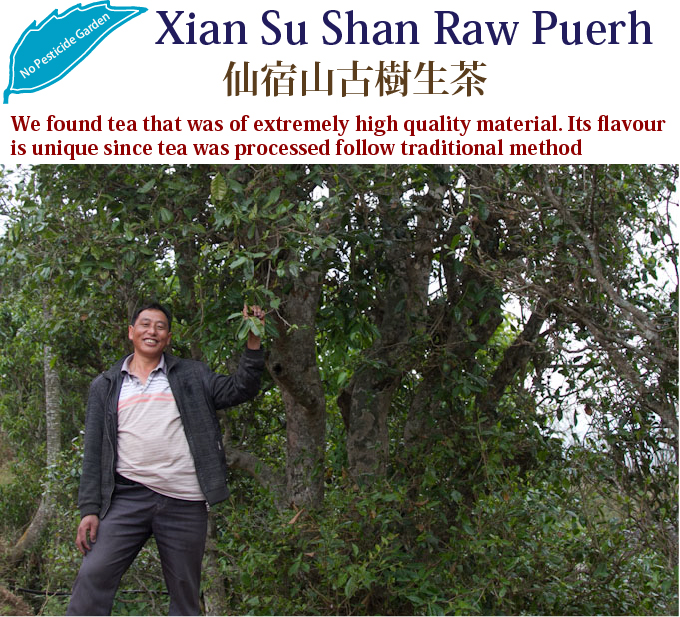 This photo is the image of a Yi race farmer and the old tea tree. But this is not the tea tree that produced Xian Su Shan raw pu-erh
This photo is the image of a Yi race farmer and the old tea tree. But this is not the tea tree that produced Xian Su Shan raw pu-erh
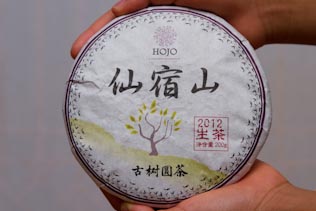 |
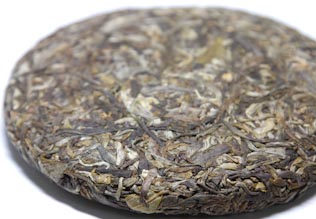 |
|
Tea is produced in 2012. It is compressed into 200g of tea cake |
A closer look at the tea cake. It has many tea leaves that are covered with white downy hair. Tea is plucked at the end of March 2012. |
Tea is full body, with thick and long-lasting taste.
Xian Su Shan is a mountain located in Lin Cang. Lin Cang is a regional city situated in South West of Yunnan.
Starting from 2011, we mainly source our pu-erh tea from Lin Cang. The reason is the infrastructure in Lin Cang remains less developed. From Lin Cang, it takes about 10 hours driving time to reach the village that produces Xian Su Shan. In the mountains, still home to many ethnic minorities, and they live a traditional lifestyle. Even today, they still follow the ancient practice of growing tea. Besides, the soil in Xian Su Shan is very rich in iron. This area is relatively dry throughout the year. Thus, tea spends a long time for growing. As a result, tea gives a complex flavour and the taste become very thick.
The tea tree in Xian Su Shan belongs to Yi race (彝族), one of the ethnic minorities in Yunnan. They are mainly dependent on the agricultural products for a living. This tea is grown and processed solely by Yi race. They use a very traditional method of making tea. The tea is fried using the wood-fired pan which has been traditionally used for generations. In fact, it is difficult to control the fire of wood-fired pan. Due to this problem, tea often gives the aroma that reminds us of wood fire. Therefore, it is necessary to use boiling water and rinse tea twice so that the flavour is more refreshing.
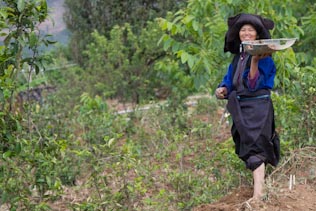 |
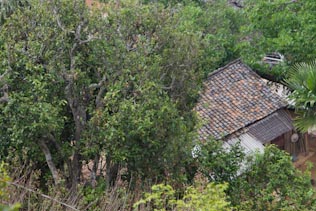 |
|
In Yunnan, old tea trees belong to ethnic minorities. |
A very old tea tree grown next to the house of minority race in Yunnan. |
Xian Su Shan raw pu-erh is made from one of the best materials we purchased in 2012. The tea gives full body and strong after taste. The lingering sweetness and the flavour stay on the throat for a long time. Tea is plucked at the end of March. Thanks to the delicacy of material, the leaf is silver-white. The flavour is like flower, grass, while slightly beany aroma.
I recognized that tea quality is extremely outstanding, yet for now its flavour is a little less appealing. However, I decided to purchase this tea because of its price is very attractive. This tea will transform into very good character with attractive honey flavour after keep it for a few years. This is the main point that I recommend this tea to my customer. For further maturation, please keep tea un-opened. Tea is vacuum-packed with oxygen absorber to eliminate oxygen and moisture from the bag. With this method, tea can be well-matured over time.
In a few years of storage at a warmer place, tea starts giving the flavour like honey.
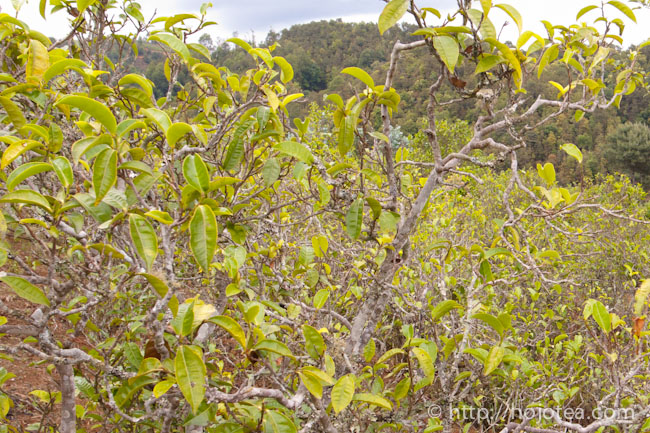
Have you ever heard the golden tea leaf? It is referring to the tea leaves in very yellow color, it looks like the rice field just before harvest. The tea leaves turn into yellow color due to it lacks nitrogen. This happens when the tea is grown with the natural farming method (without fertilizer) in the red or yellow soil. The colour of tealeaf is very close to the colour of ripen banana skin. These teas could grow very strong even if human does nothing. Under the balance ecology system, it grows very well and it does not require any fertilizer and pesticide. When we observe these tea gardens, we will notice a lot of organisms, including insects. Nevertheless, tea tree has a strong resistance to insects and keeps very healthy condition. It grows very slowly. Compare to ordinary tea that is grown with lots of attention, this naturally grown tea spent much longer time in growing. As a result, the plant produces very tiny cells but in very large quantity. Even though the growing speed is slow and the leaves very yellow in colour, it is very rich in polyphenols and minerals, and that gives full body, deep after taste and very soft texture. These are the factors that could satisfy our palate; that's why it is known as the golden tea leaf.
On the other hand, the modern agriculture uses plenty of nitrogen-based fertilizer. With nitrogen fertilizer, tea grows very fast and stops producing the functional substance such as polyphenols. The leaf grows very big, becomes dark green in colour with strong vein, and the surface of leaf becomes glossy due to the wax. The fertilizers make tea grows much faster and the leaf needs to carry out effective photosynthesis. This is why modern agriculture produces tea with big leaves that contain huge quantity of chlorophylls. Apparently, these leaves look very gorgeous, yet it gives very flat and light taste.
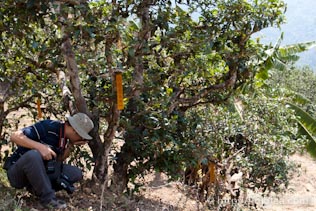 |
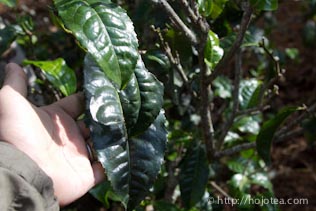 |
|
Modern agriculture + Fertilizer
Big and dark green leaf. No grasses on the ground. |
Modern agriculture + Fertilizer
Tea contains a lot of amino acid. It grows very huge, yet it is very fragile. |
|
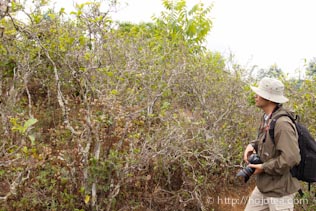 |
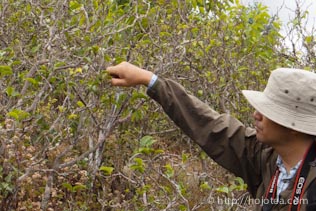 |
|
Natural Farming
It does not look like tea; but like the wild plants. The leaf is very small and in yellowish green colour. |
Natural Farming
You may be surprised that these teas and the above green leaf are the same cultivar. |
If you look at the surrounding natural environment, you may realize that the natural plants are yellowish green colour, unless the plants grown under the shade or nearby the agricultural land or plants that are cut by grass cutter, the leaves of these plants are normally darker green in colour. Just like we enjoy the taste of natural herbs or wild mushroom, we appreciate tea that is grown just like the wild plant and live as part of the ecology. Every year, we go to Yunnan and look for tea with yellow leaves.
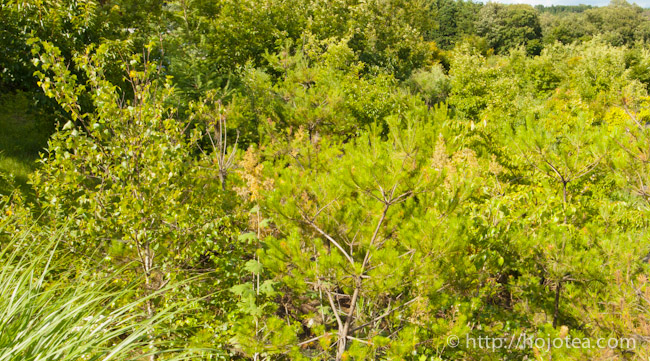
The natural plants grown under the sunshine are yellowish green colour.
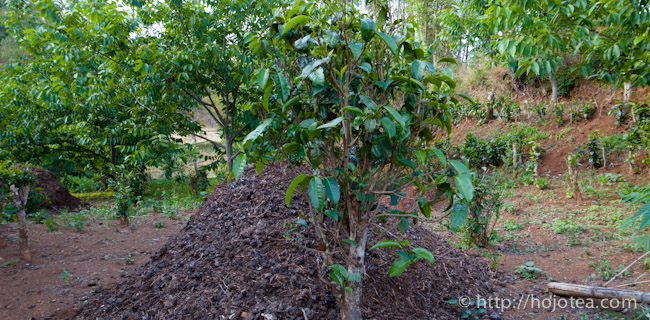
Right next to the place where animal-based fertilizer is applied, I noticed that particular tea tree has big leaves. Although it is the organic fertilizer, tea grows very fast and leaves become so green.

The tea tree in the center has very green ad big leaves. This tree was old enough and it is always sought after by many tea merchants in commercial tea market. Thus, farmer felt they can obtain high returns on this tea tree. They applied fertilizer and took good care of the tree. As a result, it grows very fast and produces very big and green leaves.
The three main production areas of pu-erh tea is Xishuang-banna, Lin Cang and Pu-erh. In these three places, Xishuang-banna is the most famous.
Xishuang-banna has historically famous place, such as Yiwu, Bu Lang Shan or Lao Ban Zhang. In the past few years, it took us more than a day to reach some of the villages. These places were quite isolated and not publicly. Nowadays, the access to these places becomes much easier, thanks to the road construction. In less than three hours, these places can be reached. Many local visitors or even tourists from other provinces often visit these places, since buying tea directly from tea garden is sort of a fun activity. Sometimes, at the minority village located in the mountain of Xishuang-banna, we can even see the BMW or Porsche. Since many people are rushing to obtain tea from these famous places, the tea price keeps rising and yet the quality drastically reduces. When the demand on tea tremendously increases, farmers will find a way to increase the output to fulfil the demand. Thus, they stop traditional farming and start applying a lot of fertilizer in order to increase the output. These situation is really spoiling the quality of tea in the historically the famous production area. For us, we seldom purchase tea in Xishuang-banna. The tea is too expensive for its quality.
HOJO focus in tea from Lin Cang. From my point of view, Ling Cang is a very ideal place for producing quality tea. One of the important reasons is that this place is not well-developed. Some of the villages are at remote location and cannot be reached by car. I prefer those minor places is mainly because of the tea tree is maintained at very natural condition. Since these villages are less popular, farmers pay less attention to the output. They leave the tea tree just like their ancestor's way. The tea plucking is only once a year. Besides, no pesticide and no fertilizer is applied. The only natural fertilizer is given by chicken; only if the tea tree is very lucky, chickens may drop a "gift" as they wander at tea garden. In addition, for the production of high-quality tea, Lin Cang's environmental condition is flawless. First of all, the total rainfall in Lin Cang is very low. It is a very dry area indeed. Most of the land here is very rich in red clay and the altitude of the Lin Cang is very high. Due to these factors, tea in Lin Cang grows very slowly and accumulates a lot of minerals. Once we tasted these teas, it is very uneasy to reverse back to the previous quality. The tea is so soft and smooth. We can tell the difference even if we drink it while pinching our nose.
Honestly speaking, no matter how well the pu-erh tea is made or matured, in terms of flavour, it never is able to compete with the well-made oolong tea. For example, the flavour of Phoenix Dan Cong oolong is marvellous. I often say that oolong tea is appreciated because of its flavour, while pu-erh tea is valued for its taste. Nevertheless, there is oolong tea that gives good taste as well as nice flavour. However, please compare the price of oolong and pu-erh tea. Usually, if oolong tea has both good flavour and taste, the price is sky-high. As for pu-erh, its flavour may not be as great as oolong. But we can often find pu-erh tea that gives extraordinarily nice taste. In this context, nice taste is refers to after taste, soft, smooth, thick and long lasting sweetness. Generally, oolong is produced in Fujian or Guangdong province. These tea regions are more open and better-known. So there is no more "Indiana John’s story". Pu-erh tea comes from Yunnan province. The Yunnan province has less exposure to the outside world. Many small villages are scattered in the mountain. Some of them are not even indicated on the Yunnan map. Only if tea buyer knows the specific place, it is possible to find the extraordinarily quality tea at very low price. We still stand a lot of chances to enjoy the fantasy of treasure hunting.
The flavour of pu-erh becomes very attractive, if it is well-kept. It may not be as perfect as some of the fine oolong, but its flavour becomes very fruity and sweet like honey. Usually, tea starts developing the honey flavour in 2-3 years’ time and fruitiness appears from 5 years’ time onwards. I believe the best timing to drink pu-erh tea is within 5-10 years’ time. However, some people like aged tea that has been kept for 20 to 30 years. I think it is personal preference.
I would like to explain the point of selection for tea we purchased in 2012. Usually, I buy tea from minority races. They own the old tea trees inherited from their ancestors. Some of the tea trees have been there more than 1000 years. Till today, they practice very traditional farming. If we require good quality tea, it is very essential to purchase it from minority races. With natural farming method, the raw material quality is superb. However, the disadvantage of getting tea from them is their process control is less precise. Normally, the pan-frying of tea is carried out with wood firing. With this method, it is difficult to control the consistent or ideal temperature. Sometimes tea is over-fired. Usually I am taking note of the over-fired flavour and try not to purchase. However, if the tea base quality is extremely high and the price is very reasonable, I will consider to purchase. It is ideal to keep for further maturation. High quality tea is refers to tea is very rich in polyphenols and this is the key element for maturation. Once the tea is well-matured, the over-fired flavour disappears. After ideal maturation, the price of tea will be adjusted. For pu-erh tea, it is common that price is raised in proportion to the maturation period. Since these teas are less expensive, one of the ways is to buy extra quantity and keep for some time. In any case, tea produced from the quality material is nice to enjoy even it is fresh. Although it may give slight over-fired flavour, it is sweet with very smooth drinking feeling.
Here’s the list of our pu-erh teas:
Bai Ying Shan Raw Pu-erh 2008
Bai Ying Shan Raw Pu-erh 2012
Da Xue Shan Wild Pu-erh 2010
Du Mu Chun Raw Pu-erh 2012
Xian Su Shan Raw Pu-erh 2010
Xiu Lin Wu Hao Raw Pu-erh 2011
Zhong Shan Raw Pu-erh 2012
Xian Su Shan Raw Pu-erh has very marginal extent of effect from the firing process. It is a well-made tea from the extraordinarily good material. It gives full body, long-lasting taste and very smooth texture, with a lingering sweetish taste. In fact, you can enjoy this tea for now, and do not have to wait until the tea is matured.
Next to Da Xue Shan Wild Pu-erh, Xiu Lin Wu Hao Raw Pu-erh gives the strongest after taste among the teas. This tea is so smooth and soft, with flavour like sugar cane and honey. Although it has slightly smoky flavour like scotch, some customers like this tea very much as they love good scotch.
Zhong Shan Raw Pu-erh is also made from very good material. This tea was slightly over-fried. It gives a little baked aroma like bean.

Tea garden and scenary situated near Lin Cang City
 |
 |
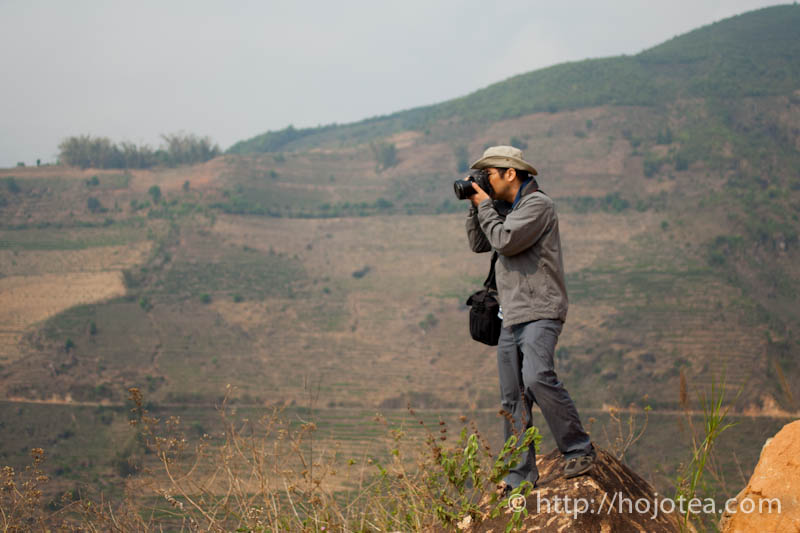 |
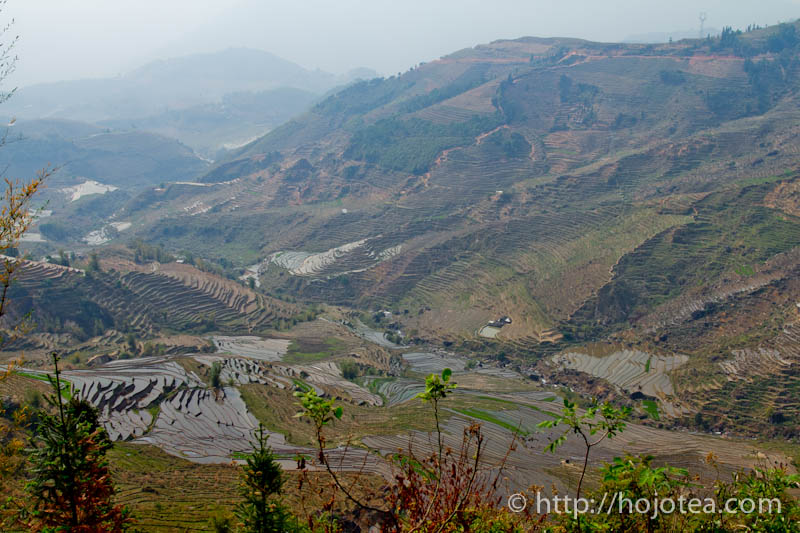 |
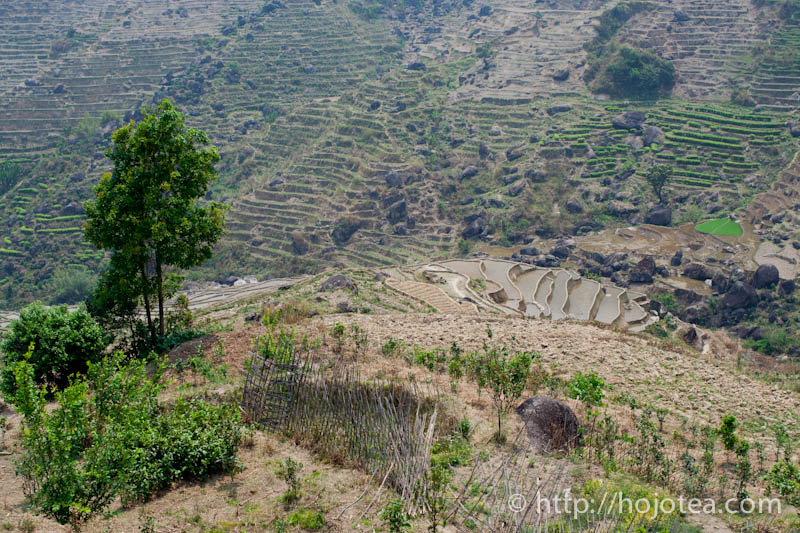 |
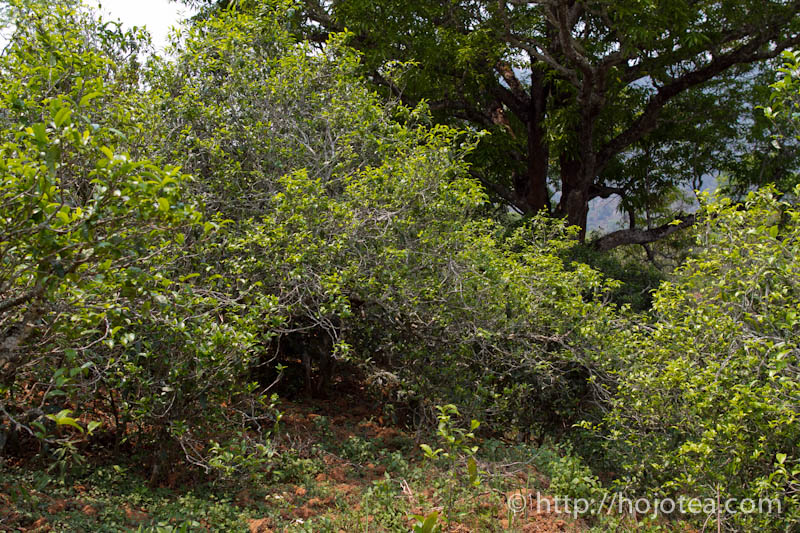 |
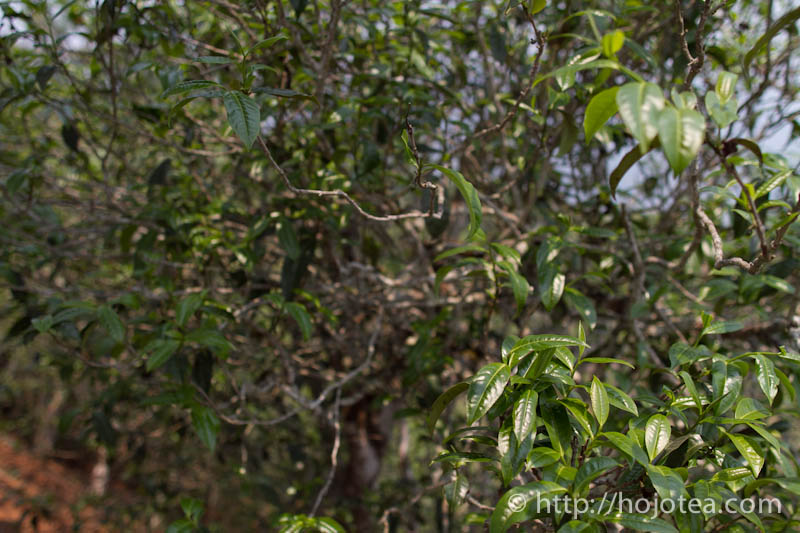 |
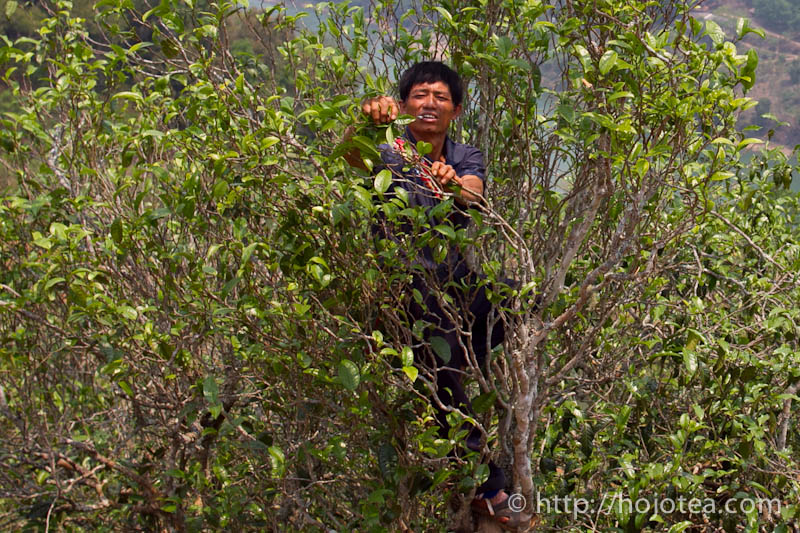 |
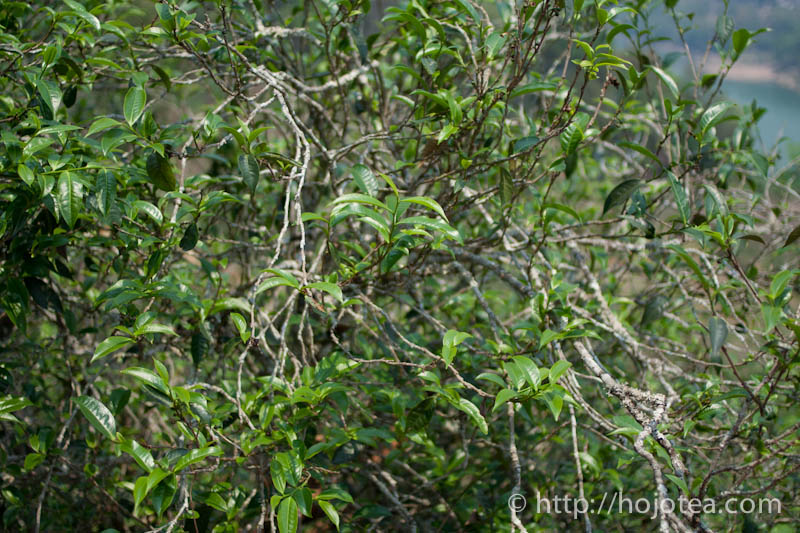 |
 |
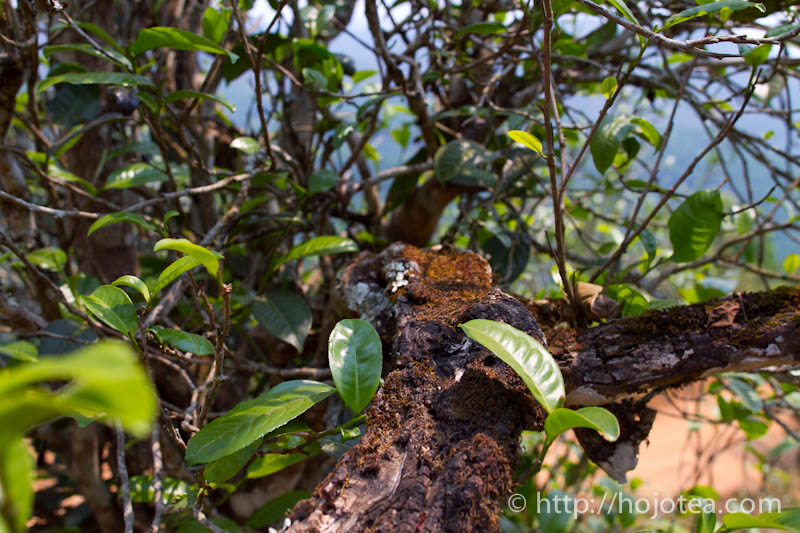 |
 |
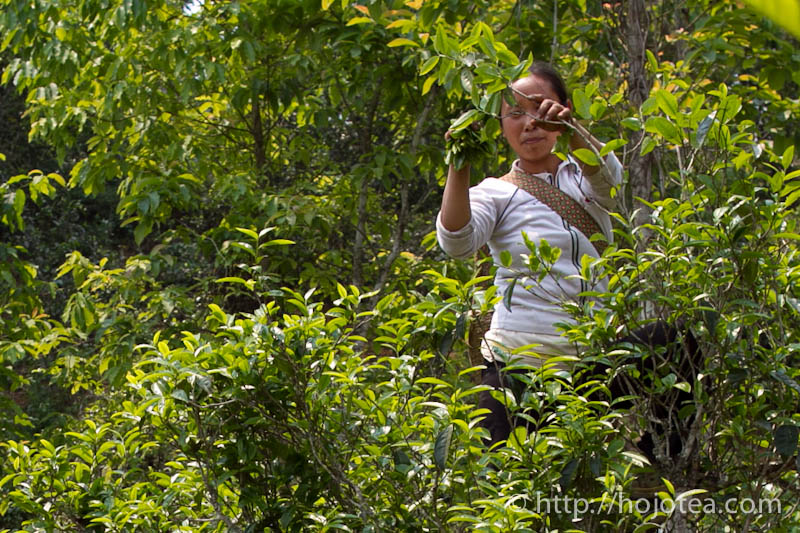 |
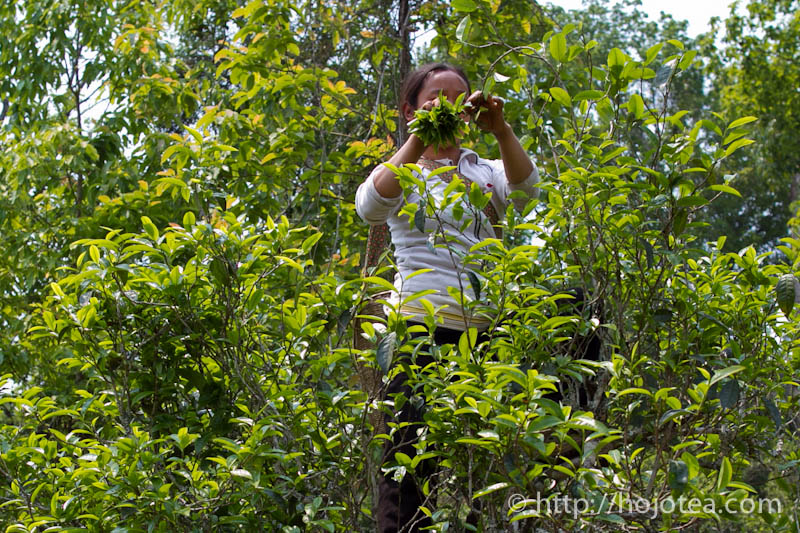
|
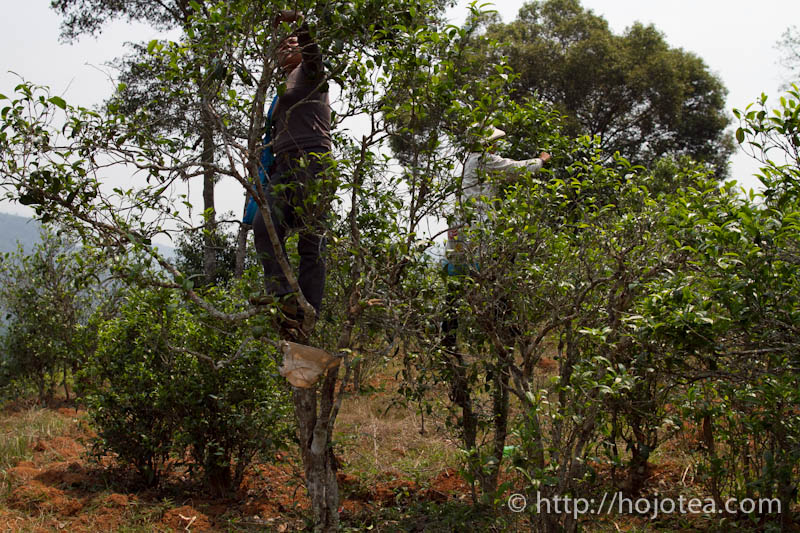 |
 |
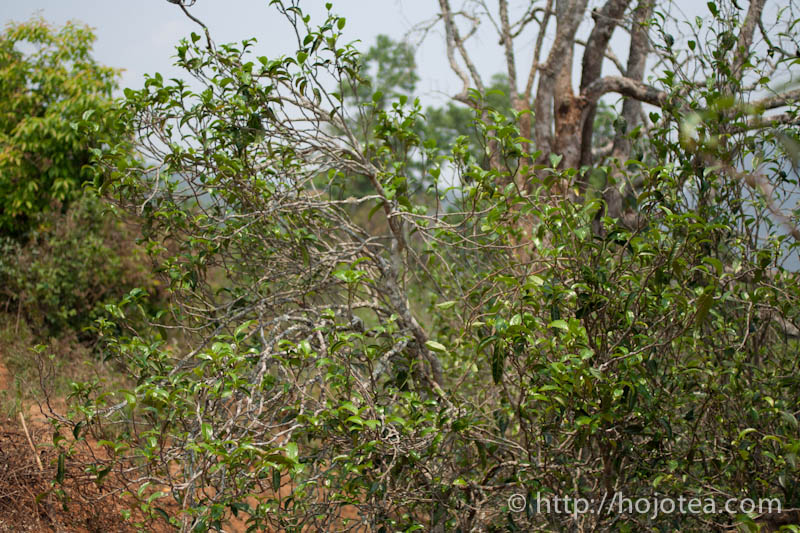 |
 |
 |
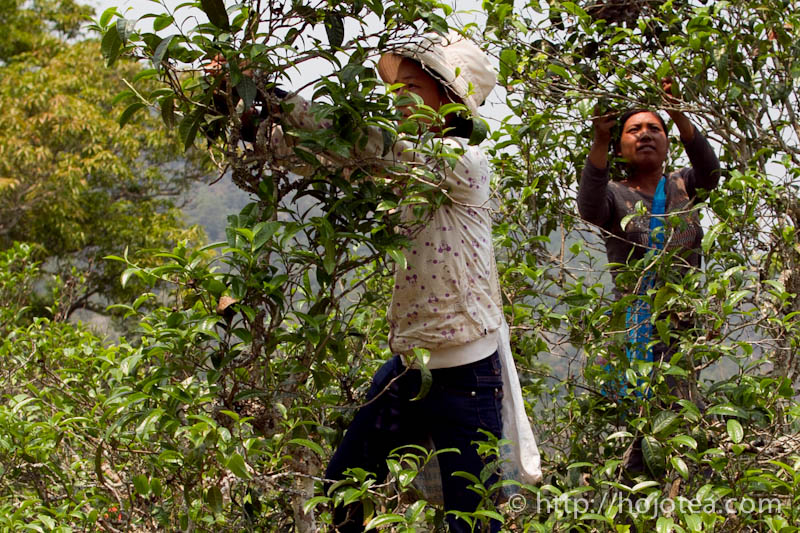 |
By far, many customers associate Pu-erh tea as tea with liquor that is dark brown in color and gives moldy or muddy smell. In fact, tea that has “brown liquor and moldy smell” is just referring to one type of Pu-erh teas, we call it Pu-erh ripe tea. Pu-erh ripe tea is invented back in 1973. It was produced with the microbiological fermentation. Most of Pu-erh teas available in oversea market are this sort of ripe tea. However Pu-erh ripe tea is not the original Pu-erh tea. In Yunnan province, Pu-erh tea means "raw Pu-erh". The ripe Pu-erh is considered as "export tea". Most of tea connoisseurs, me included seek for Pu-erh raw tea. Although both teas shared the same name as "Pu-erh", the Pu-erh raw tea and ripe tea is completely different kind of tea. In fact it is as different as comparing black tea and green tea.
This tea is produced by minorities in Yunnan. They were historically originated from South East Asia. Most of their tea trees existed ever since long ago. Today, these tea trees adapted into the surrounding natural environment and grew just like wild plants. Usually, they go to the mountain to pluck tea leaves whenever they need to make some money for living. The environment of the mountain where these tea trees grow is just like any ordinary mountain area. Needless to say, no fertilizer or pesticide is applied. Thanks to the fact that tea trees were left to grow like wild trees and no chemicals were applied, their natural habitat has a very efficient ecological system. The pests co-exist with their natural enemies. Thanks to no pesticide, these natural enemies of pest can survive in adequate numbers to keep the pest population under control.
Pu-erh raw tea has more than 1000 years of long history and China is the only country that produces Pu-erh tea. It was originated from Yunnan province in southwest China. In Yunnan, the locals drink this tea on a daily basis. In making Pu-erh raw tea, the quality of raw material has a critical impact on the quality of finished tea.
What are the quality criteria of good Pu-erh raw tea? We noticed that many people thought that Pu-erh tea is very special and different from other teas. However, Pu-erh tea is also one type of tea. There is no difference in its character from other types of tea. No exceptional taken just because it is Pu-erh tea.
The quality of Pu-erh consists of 2 elements.
Tea must maintain its fresh flavour. As a matter of fact, most of Pu-erh teas were stored under inappropriate environment where the humidity tends to be very high. As a result, tea loses its fresh flavour, and instead it gives oxidized and sour flavour. Many people misunderstand that this sort of oxidized flavour as the flavour of “aging”. In fact, Pu-erh tea that has undergone proper aging naturally gives a fresh fruity flavour.
If you wish to learn about Pu-erh tea in detail, please click here >>
Go to further information about suitable water for brewing tea >>
Go to further information about suitable water for brewing tea >>
It is important to pour boiling water into the teapot and leave it for about 10 seconds. Without this rinsing process, the temperature of boiling water decrease about 20 degree C when it is pour into the teapot.
Place tea leaves in teapot and pour boiling water again. Leave it for less than a second and discard the water, and immediately pour boiling water one more time and repeat the same procedure. Without this step, the temperature of tea will reduce nearly 30 degree C.
If (4) and (5) is not carried out, your brewing temperature will be 50-60 degree C. This is too low to extract sufficient flavor and taste. Please repeat rinsing process one more time. Please do not soak tea for more than a second.
You can brew up to even 8-10 brewing using the same tea leaves. From 2nd brewing onwards, it is very important to keep brewing time as short as you can. As tea leaf is wet and hot, definitely it is not necessary to brew more than a few seconds.
Note: Please remove the lid while you are waiting for subsequent brewing. If the lid is not removes, tea leaves will be over steamed and get oxidized.
Firstly, warm up the Gaiwan with boiling water, and then place tea leaves up to 60-70% of the capacity of Gaiwan. We use 1g of tea leaves for 10ml of water. So if the capacity of Gaiwan is 100ml, we need about 5g of tea leaves. Please remember to place tea leaves gently and not to compress it into the Gaiwan. Pour boiling water up to the level of tea leaves, and then place the lid and immediately pour out the water from Gaiwan. Repeat this action once more. It means you need to rinse the tea leaves twice with boiling water. This action is to warm up tea leaves and also to open up the leaves. These actions must be carried out swiftly so as not to lose the precious flavor and taste of tea.
For the actual brewing, it does not require long infusion like making other teas. Instead, you have to brew it the "touch and go" style. As soon as you pour the boiling water up to the level of tea leaves, place the lid to Gaiwan and then immediately pour out the tea without letting it soak. It is recommended to accumulate the 1st and 2nd brewing into a pitcher in order to even out the flavor and taste. For each subsequent brewing, you just need to brew less than a second. By brewing this "touch and go" style, you can continue brew up to nearly 20 times.
Note: Please remove the lid while you are waiting for subsequent brewing. Tea leaf will be over steamed and get oxidized if the lid is not removed.
Pu-erh tea can lasts more than 10 - 20 years as long as tea is kept in dry environment. Before tea is kept, it must be tightly sealed. Tea should be kept in ambient temperature and dry conditions such as in the living room and it must not be kept in humid environment like in the kitchen. Avoid enclosed area such as inside the cupboard or drawer as these places are damp. Also avoid opening the bag of tea in humid atmosphere. It is recommended to open the bag during a sunny day or under air-conditioned atmosphere. Once tea leaves absorb moisture, deterioration of tea will be triggered within a few days. Tea will give an astringent taste, and sometime it tastes sour. Its aroma also becomes weaker.
Traditionally, Pu-erh tea is compressed to remove oxygen from the leaves and kept it intact. It was the wisdom of ancient people to keep tea without oxygen and let it matured very well.
From scientific point of view, oxidation does not only refer to receiving oxygen. The oxidation also takes place when it releases hydrogen and receives electron. Even if tea is kept without oxygen, it will still undergo oxidation.
In 1960's, generally Pu-erh tea was compressed tightly and shaped like a bing (flat and thin round cake). It was called “iron bing”. The tea leaf was compressed extremely tight until it became like a piece of stone; we can hardly pry it even if we use the proper tool that designed for prying the Pu-erh cake. This style of compression succeeded the elimination of oxygen from the tea leaves. If you have ever tried this kind of Pu-erh iron bing, you would know that it was very well-matured. It gives flavour like honey with fruity note and gives no earthy flavour at all. The only problem is that it is so difficult to loosen the leaves from the iron bing and the leaves are often damaged during the process.
On the other hand, nowadays most of Pu-erh cakes are loosely compressed. Some of the Pu-erh cakes can be easily break apart by fingers. Obviously there is oxygen remained in between the leaves. If we keep loosely-compressed Pu-erh in ambient environment, tea will expose to not only oxygen but also moisture and develop unwanted oxidation that usually generates earthy flavour. To achieve the same maturation effect like the iron bing, we encourage customer to keep Pu-erh tea without oxygen. With modern technology, we are able to apply the same theory. Some people in Taiwan intentionally keep high mountain oolong in the vacuum bag for a few years. In the beginning, high mountain oolong is green in colour and it gives a delightful fresh flowery flavour. After a few years of maturation, the leaves turn into yellow colour and it gives the flavour like ripen peach or apricot. This is exactly the same effect as what we are looking for in Pu-erh tea. Based on our experience, well-matured Pu-erh tea gives a very fruity flavour and no earthy or mouldy flavour at all.

Please feel free to send us e-mail for enquiry at:

 |
We accept various kinds of credit card through Paypal.
Only if customer prefer other option of payment, we suggest "Bank Transfer".
Various choice of shipping method
EMS, SAL, Small Packet, Small Packet (SAL) Yamato Express and Surface
For shipping tea, we usually suggest small air parcel, the estimated shipping cost of tea in 100g (with wrapping material ) is
Small Parcel
USA JPY 600, EU JPY600 and Asia JPY470
Small Packet (SAL)
USA JPY380, EU JPY380 and Asia JPY320
The shipping fee to oversea by small air parcel happens to be even cheaper than domestic shipping fee in Japan.
For your information, some countries, EU in particular imposes custom duty. We need buyer to bare the duty. We are sorry, but we cannot change the amount on the invoice, and we do not mark any packages as gifts. We will strictly follow the custom regulation.
A GIFT FROM THE MOUNTAIN
since 2006
Copyright (C) 2006-2007 HOJO co.,ltd. All Rights Reserved.